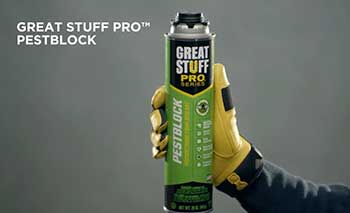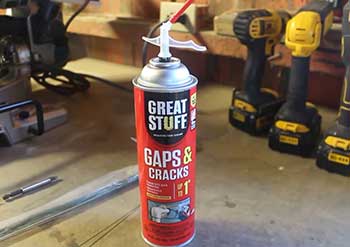If you’re dealing with unwanted pests or drafts in your home, you may be wondering about the differences between Great Stuff pestblock and gaps and cracks products. Both can help seal up holes and cracks where pests and drafts can enter, but they have some key differences.
In this comprehensive guide, we’ll compare Great Stuff pestblock and gaps and cracks products side-by-side, looking at the pros and cons of each to help you decide which is right for your needs. We’ll also answer some frequently asked questions about these popular sealants from Great Stuff.
A Brief Comparison Table
| Feature | Pestblock | Gaps & Cracks |
| Purpose | Block pests | Insulate & air seal |
| Pest deterrent | Contains Bitrex | None |
| Odor | Stronger | Milder |
| Cost | More expensive | Less expensive |
| Best Uses | Small pest entry points | General gaps for insulation |
| Cure Time | 24 hours | 8 hours |
| Expansion | Expands 2-3 times | Expands 2-3 times |
Overview Of Great Stuff Pestblock And Gaps And Cracks
Great Stuff pestblock and gaps and cracks are both insulating foam sealants made by Dow Chemical Company. Here’s a quick rundown of each:
Great Stuff Pestblock is a polyurethane foam designed to block pests from getting into your home. It expands to fill cracks and holes, and hardens into a rigid, airtight seal that deters mice, rats, insects, and more. It contains Bitrex, a bitter additive that discourages chewing or gnawing through the foam.
Great Stuff Gaps and Cracks is an all-purpose polyurethane foam sealant designed for sealing up drafty cracks and gaps around windows, doors, pipes, and more. It helps stop drafts and improve energy efficiency. It does not contain pest deterrents.
While both products are polyurethane foams, pestblock contains additional features designed to block pests while gaps and cracks focuses more on insulation. Keep reading as we explore the pros, cons, and uses of each further.
Pros And Cons Of Great Stuff Pestblock
Here are some of the main advantages and disadvantages of using Great Stuff Pestblock to seal up pest entry points:

Pros:
- Contains Bitrex to deter pests from chewing through the foam
- Expands and dries rigid to block rats, mice, insects from entering
- Seals cracks and holes up to 1 inch wide
- Forms permanent, airtight seal that won’t shrink or crack
- Can use for gaps, cracks, and holes inside or outside
Cons:
- More expensive than regular polyurethane foam sealants
- Overkill if only concerned about drafts/energy efficiency
- Stronger odor during curing due to Bitrex additive
- Can only use pestblock formula for small pest entry points, not for larger gaps
Overall, the pest-blocking abilities of Great Stuff Pestblock make it a specialty sealant ideal for keeping mice, rats, insects, spiders, and more out of your home. If pests aren’t an issue, a regular foam may be sufficient.
Pros And Cons Of Great Stuff Gaps And Cracks
Here are some key advantages and disadvantages of using Great Stuff Gaps and Cracks foam:

Pros:
- Expands to take shape of cracks and gaps for a custom fill
- Seals out drafts/moisture and insulates areas
- Foam is tack-free in 30 minutes, dries rigid in 8 hours
- Bonds to common building materials like wood, metal, masonry
- Can use indoors or outdoors to seal a wide variety of gaps
Cons:
- Not designed to deter pests from chewing through foam
- Can over-expand out of cracks if not applied properly
- Strong odor during curing period
- Not designed for gap widths greater than 1 inch
The versatility and insulating properties of Great Stuff Gaps and Cracks make it ideal for air sealing all sorts of cracks and gaps around your home. Just be aware it does not contain pest deterrents like pestblock.
Key Differences Between The Products
To summarize the main differences:
- Pest-blocking abilities: Pestblock contains Bitrex pest deterrent, gaps and cracks does not.
- Odor: Pestblock has a stronger odor during curing from the Bitrex additive.
- Cost: Pestblock is more expensive than gaps and cracks foam.
- Uses: Pestblock is specialized for pest entry points only. Gaps and cracks can seal a wider variety of gaps for insulation/draft sealing.
So in summary, if you specifically need to block pests, use Great Stuff Pestblock. If you only need to fill everyday cracks and gaps, gaps and cracks foam will do the job at a lower price point.
Also watch the video!
Applications And Uses
Now that we’ve compared the products, let’s look at how and where you can use each sealant:
Uses for Great Stuff Pestblock
Pestblock should be used to seal small holes, cracks, and gaps that allow pests to enter your home. Common applications include:
- Sealing holes where pipes, vents, utilities enter the home
- Filling gaps around windows, doors, siding, and foundations
- Blocking holes and entry points in attics, basements, garages
- Sealing around AC units, vents, lights fixtures, and wiring holes
Pestblock works great anywhere mice, rats, insects, spiders or other pests can find a way into your home. The key with pestblock is to only use it for small gaps – it’s not suitable for filling larger voids.
Uses for Great Stuff Gaps and Cracks
Gaps and cracks foam has a wider range of insulation and air-sealing applications:
- Filling drafty cracks and gaps around windows, doors, siding, etc
- Sealing gaps around pipes, vents, wiring, and utilities
- Insulating rim joists in basements and attics
- Filling knot holes and cracks in wood or masonry
- Sealing HVAC ductwork connections
- Insulating behind outlet covers and around fixtures
Gaps and cracks works well for general crack filling, both indoors and outdoors. The key is to use it anywhere you need permanent insulation and air sealing.
Also Read: Is Pestblock Foam Better Than Regular Foam?
Tips For Applying The Sealants
Proper application technique is important when using Great Stuff foams:
- Surfaces should be clean and dry before applying
- Dispense in beads or blobs instead of one continuous stream
- Foams will expand 2-3 times original size, so don’t overfill gaps
- Allow sealants to fully cure before touching or painting over them
- Apply when temperatures are between 60-100°F
- Follow all precautions on packaging before using
Also be very careful not to use too much, as excess foam is difficult to remove once cured. Filling gaps about halfway allows room for expansion.
Frequently Asked Questions (FAQ)
Great Stuff Pestblock contains a bittering agent called Bitrex to deter pests from chewing through the cured foam. Regular Great Stuff is an insulating foam only.
The Bitrex additive makes Great Stuff Pestblock very unappealing to rodents like mice and rats. The bitter flavor deters them from chewing through it once cured. Be sure to allow full 24 hour curing time before exposure.
When cured, the rigid foam sealant lasts permanently. Over time it may yellow from UV exposure but remains an effective sealant for many years.
No, Great Stuff Pestblock does not contain any pesticides. It relies on the bitter taste of Bitrex to deter pests, not kill them. Always check local regulations before using pestblock.
Also Read: Comparison Between Ecoshield And Terminix.
Final Thoughts
In conclusion, Great Stuff Pestblock and Gaps and Cracks offer two polyurethane foam solutions – one for pest control, and one for insulation. Pestblock specifically blocks rodents and insects thanks to its Bitrex additive. Gaps and Cracks lacks pest deterrents but offers versatile, insulating sealing for cracks throughout buildings.
When applied properly in beads that allow for expansion, both products can provide long-lasting seals for either pest exclusion or energy efficiency. Just be sure to use pestblock strictly for pest entry points, and gaps and cracks for general insulation and air sealing needs. Consider the differences and your specific needs to decide which sealant is the right fit.
